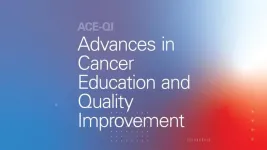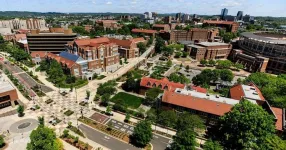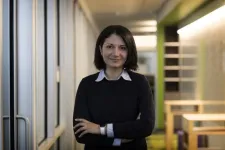(Press-News.org) An innovative analysis of shared segments within the genome — an indication of distant “relatedness” — has identified undiagnosed cases of Long QT syndrome, a rare disorder that can lead to abnormal heart rhythms, fainting and sudden cardiac death.
The findings, reported in the journal Nature Communications, illustrate the feasibility of the new approach developed by researchers at Vanderbilt University Medical Center to detect undiagnosed carriers of rare disease-causing genetic variants.
“Rare genetic diseases are usually studied in referral populations — people who have been referred to specialty clinics for evaluation — but this approach often overestimates the true population impact, which would be better assessed in large non-referral populations, such as biobanks,” said Jennifer (Piper) Below, PhD, professor of Medicine in the Division of Genetic Medicine and senior corresponding author of the new study.
Because most biobanks recruit participants from the same region, there is often significant undocumented relatedness among the participants, resulting in genomic segments that are shared due to common ancestry — “identical-by-descent” segments, Below explained.
“Identical-by-descent segments give us an opportunity to cluster related people to find rare variants that were present in a common ancestor,” she said.
To do this, the researchers developed a genetic inference method called DRIVE (Distant Relatedness for Identification and Variant Evaluation). The studies were led by co-first authors Megan Lancaster, MD, PhD, a clinical fellow in the Division of Cardiovascular Medicine, and Hung-Hsin Chen, PhD, who was a postdoctoral fellow in the Division of Genetic Medicine. Dan Roden, MD, the Sam L. Clark, MD, PhD Chair and Senior Vice President for Personalized Medicine, is co-senior author.
To test DRIVE, the researchers focused on a rare variant in the gene KCNE1 that causes Type 5 Long QT syndrome (LQT5). The KCNE1 gene encodes a protein that modifies potassium currents.
An international consortium of 26 centers had identified 89 probands (affected individuals who are the first subjects of a genetic study) with possible LQT5, 140 additional carrier relatives, and 19 cases of another syndrome attributed to variants in KCNE1.
Of 35 probands with the most common KCNE1 variant (p.Asp76Asn), nine (26%) were evaluated by the Genetic Arrhythmia Clinic at VUMC. None of the probands were known to be related. Three relatives of the probands were also found to carry the variant.
“This enrichment of a rare variant at VUMC relative to other centers in the consortium suggested that these local probands may be distantly related and that we could use that relatedness to identify additional carriers in BioVU,” Below said. BioVU is VUMC’s DNA biobank linked to de-identified electronic health records.
The team first estimated the genome-wide relatedness of the 12 clinically identified p.Asp76Asn carriers and constructed lineage pedigrees. They found eighth to ninth degree relatedness among these pedigrees (for reference, fourth cousins — great-grandchildren of first cousins — are ninth degree relatives), supporting the hypothesis of a local common ancestor with the p.Asp76Asn variant.
Then, the researchers identified shared genomic regions that spanned the KCNE1 gene and applied DRIVE to 69,819 BioVU subjects. They identified 22 BioVU subjects with the shared region, confirmed the p.Asp76Asn variant by DNA sequencing, and assessed electrocardiograms and medical records for features of LQT5.
Both referral and non-referral carriers of the variant have prolonged QT interval compared to controls.
“In this study, we used DRIVE to rapidly pinpoint 22 carriers of a previously described pathogenic gene variant,” Below said. “DRIVE could also be used to identify unknown causal gene variants, by clustering individuals with shared identical-by-descent segments and assessing the enrichment of disease within clusters.
“We’re excited about the potential of DRIVE to identify undiagnosed cases of genetic disease.”
Co-first author Chen is now a tenure-track assistant research fellow of the Institute of Biomedical Science at Academia Sinica in Taiwan and holds a joint faculty appointment at VUMC. Other authors of the Nature Communications study include Benjamin Shoemaker, MD, Matthew Fleming, MD, PhD, Teresa Strickland, James Baker, Grahame Evans, Hannah Polikowsky, David Samuels, PhD, and Chad Huff, PhD. The research was supported in part by the National Institutes of Health (grants R01GM133169, R01HL159557, P50GM115305, U01HG011181, T32HG008962, T32GM007569, T32GM145734) and the American Heart Association.
END
Distant relatedness in biobanks harnessed to identify undiagnosed genetic disease
New method applied to rare cardiac disorder: Long QT syndrome
2024-09-27
ELSE PRESS RELEASES FROM THIS DATE:
UCLA at ASTRO: Predicting response to chemoradiotherapy in rectal cancer, 2-year outcomes of MRI-guided radiotherapy for prostate cancer, impact of symptom self-reporting during chemoradiation and mor
2024-09-27
UCLA Health Jonsson Comprehensive Cancer Center researchers and physicians who specialize in treating patients with radiation therapies will present data on the latest radiation oncology research and clinical trial results at the 66th annual American Society for Radiation Oncology (ASTRO) meeting in Washington D.C., Sept. 29 to Oct. 2.
The annual meeting, which is the leading meeting in radiation oncology, will feature 23 abstracts from UCLA investigators that highlight key areas of radiation oncology, including new research in subspecialties ranging from survivorship, lung cancer/thoracic malignancies, physics, sarcoma, gastrointestinal cancer, genitourinary cancer, gynecological ...
Estimated long-term benefits of finerenone in heart failure
2024-09-27
About The Study: In this prespecified secondary analysis of the FINEARTS-HF randomized clinical trial, long-term treatment with the nonsteroidal mineralocorticoid receptor antagonist finerenone was estimated to extend event-free survival by up to 3 years among people with heart failure with mildly reduced or preserved ejection fraction.
Corresponding Author: To contact the corresponding author, Scott D. Solomon, M.D., email ssolomon@rics.bwh.harvard.edu.
To access the embargoed study: Visit our For The Media website at ...
MD Anderson launches first-ever academic journal: Advances in Cancer Education & Quality Improvement
2024-09-27
The University of Texas MD Anderson Cancer Center today announced its first-ever academic journal, Advances in Cancer Education & Quality Improvement (ACE-QI). The journal will publish research, training program summaries and quality improvement interventions for the oncology provider community.
The open-access, peer-reviewed journal will feature research and professional perspectives focused on training health care providers to meet myriad challenges around prevention, diagnosis, treatment and survivorship in cancer care.
“We envision this journal as a catalyst for critical conversations across the cancer care continuum," said Joshua Kuban, M.D., associate ...
Penn Medicine at the 2024 ASTRO Annual Meeting
2024-09-27
PHILADELPHIA – Leading experts in radiation therapy from Penn Medicine’s Abramson Cancer Center and the Perelman School of Medicine will present new results from clinical trials and research studies at the American Society for Radiation Oncology's (ASTRO) 66th Annual Meeting, which will be held at the Walter E. Washington Convention Center in Washington, D.C., Sept. 29 through Oct. 2, 2024.
At the meeting, Neha Vapiwala, MD, FACR, FASTRO, FASCO, the Eli Glatstein Professor in Radiation Oncology, will take office as president-elect of ASTRO as the first Penn faculty member to lead the premier society ...
Head and neck, meningioma research highlights of University of Cincinnati ASTRO abstracts
2024-09-27
University of Cincinnati Cancer Center experts will present research at the American Society for Radiation Oncology (ASTRO) Annual Meeting Sept. 29 through Oct. 2.
Osteoradionecrosis more common in patients with head and neck cancer that requires partial jaw removal
Following radiation treatment for head and neck cancer, some patients can experience osteoradionecrosis (ORN) when an area of exposed bone fails to heal after a three-month period.
“ORN of the mandible and maxilla (jaw bones) can be very debilitating, as it often causes severe pain, fistula formation, infection and susceptibility to fractures,” ...
Center for BrainHealth receives $2 million match gift from Adm. William McRaven (ret.), recipient of Courage & Civility Award
2024-09-27
Center for BrainHealth® at The University of Texas at Dallas has received a major match gift commitment from retired U.S. Navy four-star admiral and former University of Texas System chancellor William McRaven and his wife Georgeann. Adm. McRaven recently received the 2024 Bezos Courage & Civility Award presented by Amazon founder Jeff Bezos and Lauren Sánchez.
The $2 million challenge grant will support Optimal BrainHealth for Warfighters – including active-duty military, spouses and veterans. This program will help those with traumatic brain injury (TBI), post-traumatic stress (PTS) and similar issues, as well ...
Circadian disruption, gut microbiome changes linked to colorectal cancer progression
2024-09-27
Irvine, Calif., Sept. 27, 2024 — Research from the University of California, Irvine has revealed how disruption of the circadian clock, the body’s internal, 24-hour biological pacemaker, may accelerate the progression of colorectal cancer by affecting the gut microbiome and intestinal barrier function. This discovery offers new avenues for prevention and treatment strategies.
The study, published online today in the journal Science Advances, offers a more comprehensive understanding of how important changes occur in the function and composition of the gut microbiome when the circadian clock is disturbed in the presence ...
Grant helps UT develop support tool for extreme weather events
2024-09-27
The University of Tennessee and the UT Institute of Agriculture have received a $434,038 Seeding Solutions grant from the Foundation for Food & Agriculture Research (FFAR) to develop and test a decision support tool for farmers to better manage crop production from risks of extreme weather events across the Tennessee River Basin and surrounding southeast US regions.
UT is providing matching funds for a total investment of $966,119 over the three-year project.
The U.S. Department of Agriculture estimates that extreme weather is responsible for 90% of crop losses. These estimates are generally based on annual climate conditions. ...
Autonomous vehicles can be imperfect — As long as they’re resilient
2024-09-27
Researchers from three of Virginia’s premier universities, including the University of Virginia’s Homa Alemzadeh, aim to take the risk out of self-driving vehicles by overcoming inevitable computer failures with good engineering.
The trio will share a $926,737 National Science Foundation award to identify when and where autonomous vehicle systems are most vulnerable to safety-critical failures. They plan to use this knowledge to design ways to efficiently mitigate potential safety hazards and enhance the overall system resilience.
Alemzadeh, an associate professor of electrical and computer engineering in UVA’s School of Engineering and Applied ...
Asteroid Ceres is a former ocean world that slowly formed into a giant, murky icy orb
2024-09-27
Since the first sighting of the first-discovered and largest asteroid in our solar system was made in 1801 by Giuseppe Piazzi, astronomers and planetary scientists have pondered the make-up of this asteroid/dwarf planet. Its heavily battered and dimpled surface is covered in impact craters. Scientists have long argued that visible craters on the surface meant that Ceres could not be very icy.
Researchers at Purdue University and the NASA's Jet Propulsion Lab (JPL) now believe Ceres is a very icy ...
LAST 30 PRESS RELEASES:
Manta rays create mobile ecosystems, study finds
Study: Mixed results in using lipoic acid to treat progressive multiple sclerosis
Norbert Holtkamp appointed director of Fermi National Accelerator Laboratory
New agentic AI platform accelerates advanced optics design
Biologists discover neurons use physical signals — not electricity — to stabilize communication
Researchers discover that a hormone can access the brain by hitchhiking
University of Oklahoma researcher awarded funding to pursue AI-powered material design
Exploring how the visual system recovers following injury
Support for parents with infants at pediatric check-ups leads to better reading and math skills in elementary school
Kids’ behavioral health is a growing share of family health costs
Day & night: Cancer disrupts the brain’s natural rhythm
COVID-19 vaccination significantly reduces risk to pregnant women and baby
The role of vaccination in maternal and perinatal outcomes associated with COVID-19 in pregnancy
Mayo Clinic smartwatch system helps parents shorten and defuse children's severe tantrums early
Behavioral health spending spikes to 40% of all children’s health expenditures, nearly doubling in a decade
Digital cognitive behavioral treatment for generalized anxiety disorder
Expenditures for pediatric behavioral health care over time and estimated family financial burden
Air conditioning in nursing homes and mortality during extreme heat
The Alps to lose a record number of glaciers in the next decade
What makes a good proton conductor?
New science reporting guide published for journalists in Bulgaria
New international study reveals major survival gaps among children with cancer
New science reporting guide published for journalists in Turkey
Scientists develop a smarter mRNA therapy that knows which cells to target
Neuroanatomy-informed brain–machine hybrid intelligence for robust acoustic target detection
Eight SwRI hydrogen projects funded by ENERGYWERX
The Lundquist Institute and its start-up company Vitalex Biosciences Announces Strategic Advancement of Second-Generation fungal Vaccine VXV-01 through Phase 1 Trials under $40 Million Competitive Con
Fine particles in pollution are associated with early signs of autoimmune disease
Review article | Towards a Global Ground-Based Earth Observatory (GGBEO): Leveraging existing systems and networks
Penn and UMich create world’s smallest programmable, autonomous robots
[Press-News.org] Distant relatedness in biobanks harnessed to identify undiagnosed genetic diseaseNew method applied to rare cardiac disorder: Long QT syndrome




